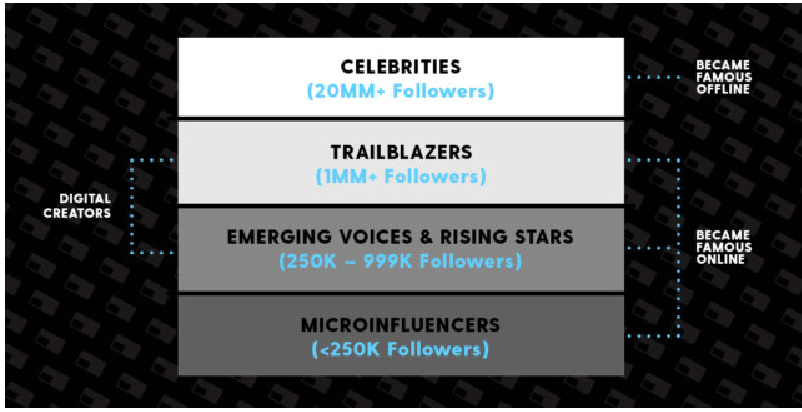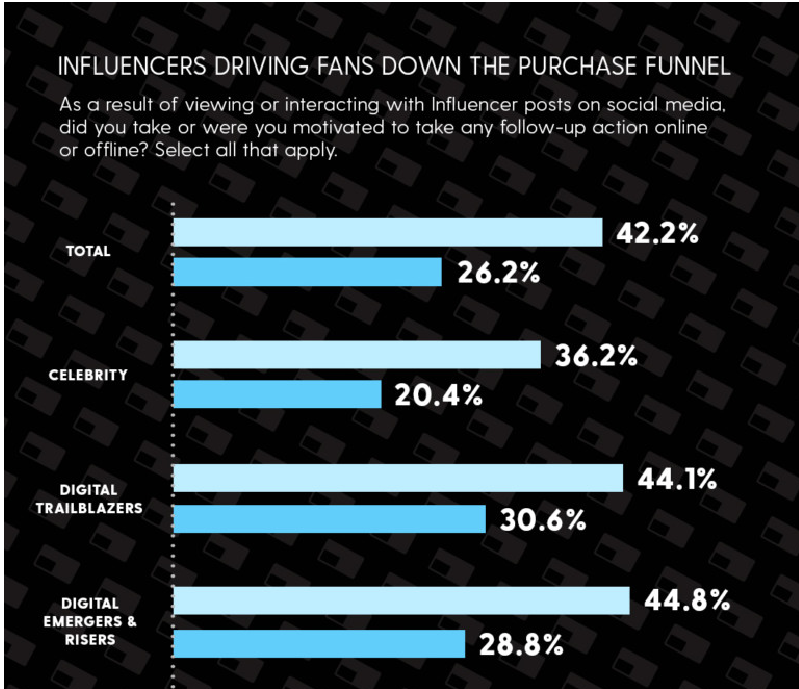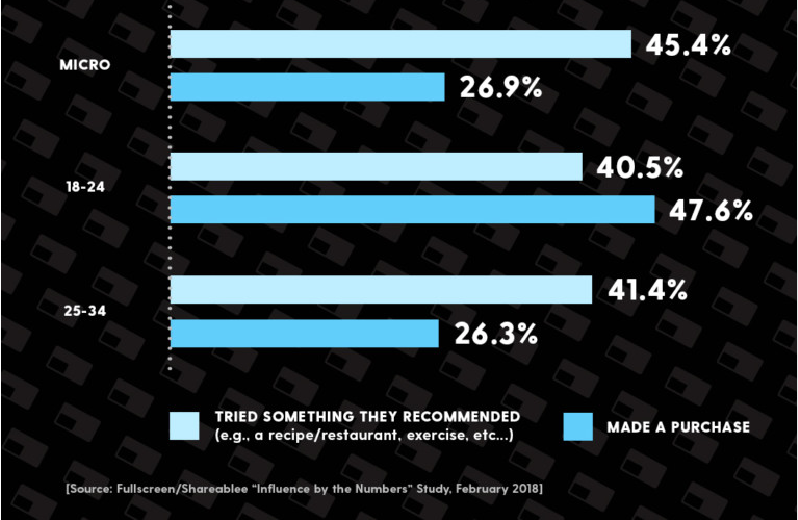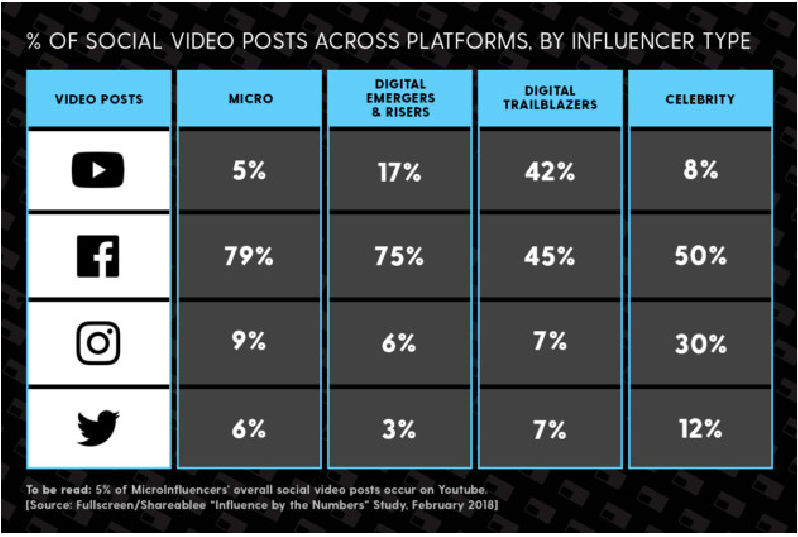New research from branded content firm Fullscreen takes a deep dive into what types of influencers—based on follower size—make the most impact.
Advancing previous research on microinfluencers, the firm’s new Influence by the Numbers report analyzed a selection of 31,000 influencers from a pool of over half a million with followings of all sizes—including Celebrities (20M+ followers); Digital Creators & Trailblazers (1M-19.9M followers), Digital Emerging Voices & Rising Stars (250K – 999K), and Microinfluencers (less than 250K followers)—to understand their content strategies and resulting fan engagement behavior across YouTube, Facebook, Instagram, and Twitter.
Additionally, the researchers surveyed 1,200 Millennial and Gen Z fans ages 18-34 to determine perceptions and attitudes, such as trust and purchase intent, toward these influencer segments and the brands that align with them.
The research, in partnership with social analytics firm Shareablee, showed that Digital Creators & Trailblazers (0.66 percent) & Digital Emergers & Risers (0.60 percent) outperformed the engagement rate of Celebrities (0.40 percent) and Microinfluencers (0.35 percent)—the two groups that have often been mistakenly associated with better engagement performance and perceived higher influence.
In addition, per the survey, more than one-third (38 percent) of those engaging with influencers trust what an influencer says about the brand more so than what the brand says about itself, with Digital Trailblazers having the highest level of trust among the influencer segments at 45 percent. Respondents were also more likely to trust Digital Creators than Celebrities about their brand perceptions.
“We noticed studies that came out about Microinfluencers were limited in a variety of ways, and we owed it to brands to take a closer look at this trend that exploded early last year,” said Maureen Polo, SVP at Fullscreen, in a news release. “This report analyzes what types of content influencers post and where, and explores how the impact of content and platform varies across each creator segment to help brands recognize how their collaborations with influencers resonate.”
“With so much positive momentum around the Influencer space, it was the right time to more formally verify the impact to brands of working with different types of Influencers, so faster decisions can be made with confidence,” said Tania Yuki, CEO at Shareablee, in the release. “We believe this is a critical first step to creating an Influencer playbook, and to removing the confusion about the relative value of Macroinfluencers and Microinfluencers when it comes to purchase consideration, levels of trust and other key metrics.”
Additional findings from the report include:
Content strategy varies as much as the platform
- With a low barrier to entry and text-heavy focus, Twitter is the most widely used platform by all Influencers (comprising between 45 percent to 58 percent of total social posts). Nearly three-quarters (70 percent) of posts by influencers on Twitter include a link while less than 5 percent include a video.
- Video creativity presents a higher barrier to entry; Digital Creators have the highest percentage of their total social posts being posted to YouTube (8 percent for Digital Trailblazers and 3 percent for Digital Emergers & Risers vs. 1 percent for Celebrities and <1 percent for Micros).
- 37 percent of Digital Emergers and Risers’ and 36 percent of Digital Trailblazers’ posts on Facebook include a video, which is a higher percentage than for Micros (20 percent) or Celebrities (19 percent).
- 23 percent of Celebrities’ posts on Instagram include videos, which is a higher percentage than Digital Trailblazers (11 percent), Digital Emergers and Risers (6 percent), and Micros (5 percent).
- Co-branded influencer posts were most prevalent on Instagram (5.3 percent), followed by Twitter (3.4 percent) then Facebook (2 percent). Across all social platforms, Microinfluencers were the segment with the highest levels of branded posting.
Trust is key to every good relationship
More than one-third (37 percent) of individuals engaging with influencer posts say that when an influencer mentions a brand, their trust in the brand increases. Trust in different types of influencers varied according to how knowledgeable and honest fans perceive them to be:
- Gen Z and young millennials trust digital content from influencers more so than from brands themselves, even if the content is about a brand’s product, trusting influencers over brands (44.3 percent) at a higher rate than older millennials (35.7 percent).
- Digital Trailblazers have created the overall highest level of trust (45 percent) amongst their fans, exceeding that of Microinfluencers (42 percent), Digital Emergers & Risers (34 percent), and Celebrities (29 percent).
- Nearly one-third of respondents trust Digital Trailblazers (32.4 percent) because they seem like they could be their friend; much higher than Celebrities (19 percent) and Microinfluencers (24.3 percent), according to their respective fans.
Transparency and influencer motivation
When broken down by types of influencers, both Gen Z and Millennials believe Digital Creators have the most altruistic intentions with their content creation, with over half (53 percent) believing they are creating content to provide interesting and useful content to fans and for self-expression.
- Young adults 18-24 are also far more likely than adults 25-34 to say that Digital Creators are making content to be useful or for creativity (58 percent).
- Microinfluencers are perceived as creating digital content mostly to earn money (83 percent) and for self-promotion (71 percent), and adults 25-34 perceived all influencers to be doing the same (68 percent), in contrast to the perceptions of the younger 18-24 segment.
Buying behaviors
Almost half (42 percent) of 18-34 report trying a product recommended by an influencer, and more than one-quarter (26 percent) say they have actually made a purchase based on a recommendation.
- Celebrity engagers were the least likely to try something recommended by the influencer (36.2 percent) or to purchase the item (20 percent).
- Microinfluencer engagers were the most likely to try something recommended (45 percent); however, Digital Trailblazer engagers were the most likely to make a purchase (30 percent), followed closely behind by Digital Emergers & Risers (28 percent).
- Adults 18-24 were also far more likely to make a purchase based on an influencer recommendation (48 percent) compared to adults 25-34 (26 percent).











